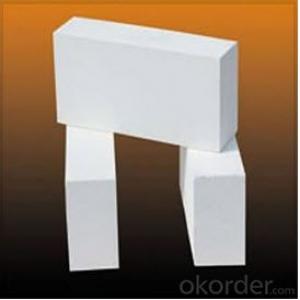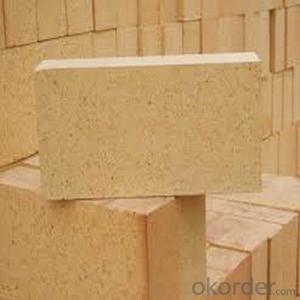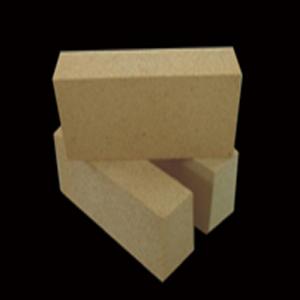High Alumina Magnesia Brick - Refractory Brick for Steel Furnace
- Loading Port:
- Tianjin
- Payment Terms:
- TT OR LC
- Min Order Qty:
- 1 m.t.
- Supply Capability:
- 2000 m.t./month
OKorder Service Pledge
OKorder Financial Service
You Might Also Like
Description of Magnesia Brick
Magnesia Brick Refractory brick for Steel Furnace is used in the transition zone and firing zone of large dry method cement kilns. Magnesia Brick is also used in the checker in the glasses furnace, metal-mixer and temperature changed frequently zones in refractory producing furnace.
Specifications for Magnesia Brick
| ITEE | Magnesia Brick | |||||
| HLMZ91 | HLMZ92 | HLMZ95A | HLMZ95B | HLMZ97A | HLMZ97B | |
| MgO%≥ | 91 | 92 | 94.5 | 96 | 97 | 97.5 |
| CaO%≤ | 3.0 | 2.5 | 2.0 | 2.0 | 1.8 | -- |
| SiO2≤ | -- | -- | 2.0 | 2.5 | 2.5 | 1.2 |
| Normal temperature compression strength Mpa p | 55 | 55 | 60 | 60 | 60 | 60 |
| softening temp.C≥ | 1520 | 1540 | 1650 | 1650 | 1700 | 1700 |
| Apparent Porosity%≤ | 18 | 18 | 17 | 18 | 18 | 16 |
Features of Magnesia Brick
Magnesia Brick , it is to point to magnesium stone as raw materials, the Israeli magnesium stone as the main crystal phase, MGO style content in 80% ~ 85% or more of the refractory brick. Its products are divided into two categories: Metallurgical magnesia and magnesia products. Magnesia brick is the main products of basic brick, high refractoriness, of alkaline slag and iron slag has good resistance, high refractory brick is a kind of important. Mainly used in open hearth, oxygen converter, electric furnace and non-ferrous metal smelting, etc.
Typical Application of Magnesia Brick
Furnaces of metallurgy industry, heat treatment furnace.
Furnaces of chemical industry and construction industry.
Furnace of incineration of garbage, recirculating fluidized bed furnace .


- Q: What are the main components of high alumina bricks?
- Sweat is like water mineral alumina bauxite, aluminum ore, magnesite, waves of gibbsite. Anhydrous alumina raw material, such as corundum, alumina, fused corundum. High alumina brick Zhengzhou gold company specializing in the production of various specifications, you can directly ask their technical staff.
- Q: What is the standard classification of high alumina bricks and high alumina bricks?
- Refractory brick is non-metallic materials can be classified according to a kind of inorganic material, high aluminum brick, clay brick, magnesia brick, corundum brick, mullite bricks, silicon carbide materials such as brick, high alumina brick is used as a relatively wide range of products in accordance with the refractory brick high alumina refractory materials by high aluminum brick is generally divided into Al2O3 content three: I - II - >75% Al2O3 content; the content of Al2O3 is 60 ~ 75%; III - Al2O3 content from 48 to 60%.
- Q: What are the reasons for the decline in the performance of high alumina bricks when we use high alumina refractory bricks?
- All the raw materials adding order, mixing time, material and material moisture trapped. 4, the pressure and the volume density of Pei brick and brick Pei size etc..
- Q: How to reduce porosity of high alumina brick
- In order to reduce the porosity of high alumina brick, the corresponding measures should be taken from the selection of raw materials, batching, mixing, molding and firing.
- Q: What kinds of minerals are there in the five major categories of ore crystal chemistry?
- Natural element minerals. Of minerals produced by an element (elementary substance). There are about 90 natural elements in the earth's crust, accounting for 0.1% of the total weight of the earth's crust. Can be divided into metal elements, mainly platinum and copper, silver, gold, etc., non-metallic elements, carbon, sulfur, etc., half metallic elements, arsenic, bismuth and so on.
- Q: How much is one ton / ton of high alumina refractory brick?
- The price of high alumina refractory bricks is not equal, according to the quality index of GB2988-2012
- Q: How to distinguish the good or bad of the high aluminum brick?
- In the procurement of high alumina brick, the first color, high quality aluminum brick, brick surface smooth, yellow color pale, four sides equal, no broken angle, no cracks.
- Q: What is the difference between high alumina brick and clay brick?
- There must be a difference. They vary in color from the amount of aluminum, the weight, the temperature, and the color. For example: 75 high aluminum and 43 clay bricks, 75 single weight 4.5kg or more. 43 3.65kg or so, the use of temperature 75, high aluminum in about 1520, 43 of brick 1430 or so, the color of 75 pan white, 43 of the Loess color. In short, the difference is great.
- Q: Does the chimney have high acid resistance?
- If it is an ordinary high alumina brick, it does not meet the requirements of acid resistance, and only the chimney lined with acid resistant bricks.
- Q: Use of high alumina refractory bricks?
- High alumina refractory brick in Al2O3 more, close to neutral refractory material, can resist acid slag and alkaline slag erosion, because it contains SiO2, so alkaline slag ability than acid resistance slag ability less.It is widely used in building blast furnace, hot blast furnace, furnace top, blast furnace, reverberatory furnace and rotary kiln lining. In addition, high alumina bricks are widely used as furnace regenerative checker, pouring system for plug nozzle, etc..
Send your message to us
High Alumina Magnesia Brick - Refractory Brick for Steel Furnace
- Loading Port:
- Tianjin
- Payment Terms:
- TT OR LC
- Min Order Qty:
- 1 m.t.
- Supply Capability:
- 2000 m.t./month
OKorder Service Pledge
OKorder Financial Service
Similar products
Hot products
Hot Searches
Related keywords






























